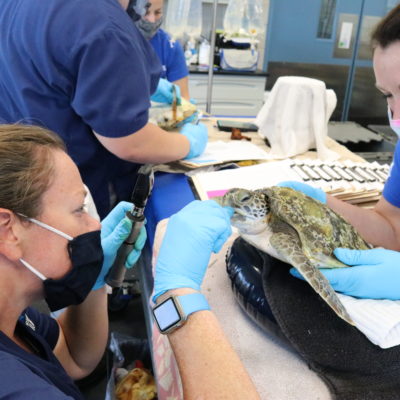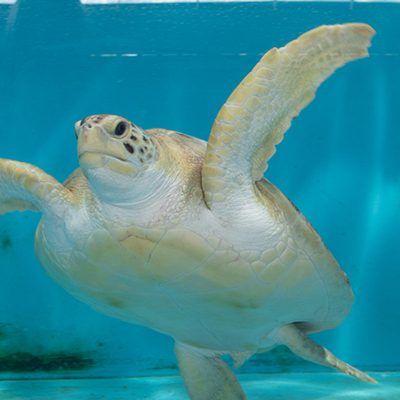Press Room
APOLLO BEACH, FL (March 18, 2025) – In an innovative step for coral restoration, The Florida Aquarium and the Florida Fish and Wildlife Conservation Commission’s Fish and Wildlife Research Institute (FWC-FWRI) have launched a new pilot project deploying the Coral Defender—a biodegradable, 3D-printed tool designed to safeguard newly outplanted corals on Florida’s Coral Reef.
Digitally designed by FWC and 3D-printed at The Florida Aquarium’s Coral Conservation and Research Center, this novel use of biodegradable materials hopes to provide early and essential protection from fish predators, helping corals survive past their first weeks in the new reef environment.
Deploying the Coral Defenders in the Florida Keys
During a recent two-day restoration effort, divers from The Florida Aquarium and FWC outplanted 660 young corals raised at the Aquarium onto four reef sites in the Florida Keys National Marine Sanctuary, including:
- 244 grooved brain corals
- 119 ridged cactus corals
- 297 symmetrical brain corals
To test the effectiveness of the new technology, scientists placed Coral Defenders on half the corals distributed among the three species to compare them to the outplants without the Coral Defenders.
CLICK HERE TO DOWNLOAD BROADCAST-QUALITY VIDEO AND PHOTOS
OF THE CORAL DEFENDER 3D PRINTING AND OUTPLANTING + SOUND
Courtesy: The Florida Aquarium
A Natural Defense Against Predators
The Coral Defender’s tripod design acts as a harmless deterrent against ravenous coral predators such as parrotfish and triggerfish. Although these fish species are vital to reef health, eating algae that can otherwise smother corals, their powerful teeth can also damage young, outplanted corals, leaving them vulnerable to fatal injuries.
“Fish predation on new outplants usually happens within the first two weeks after outplanting. We hope the Coral Defenders will naturally degrade within 3 to 6 months, or faster,” said Brian Reckenbeil, Coral Restoration Manager at The Florida Aquarium. “We designed the structures so the legs are hollow, encouraging the material to break down from both the inside and outside.”
Advancing Coral Restoration Science
The material used to print the Coral Defenders is made from polyhydroxyalkanoate (PHA), which naturally degrades in the marine environment and only produces carbon dioxide and water in the process. This environmentally friendly product was first tested for predation protection at Nova Southeastern University and approved for trial use by the Florida Keys National Marine Sanctuary. The Coral Defenders pilot project is supported by a State Wildlife Grant to the FWC. It builds on previous work by FWC and The Florida Aquarium that used bamboo skewers to protect corals. Two years ago, a longtime volunteer at the Aquarium created the concept for the “Patrick’s Parrotfish Protectors,” which used a more rigid design of bamboo skewers pre-positioned on a tile over the coral prior to outplanting.
“Our Coral Defender represents an evolution in coral restoration,” said the project leader Stephanie Schopmeyer, Research Scientist at FWC-FWRI. “By providing a biodegradable, yet effective defense against predators, we’re giving these corals a fighting chance to grow and thrive naturally.”
Monitoring & Future Research
Researchers hope the Coral Defender will provide a temporary but critical safeguard, improving coral survival rates and restoration success.
“This pioneering approach aims to reduce coral tissue losses from predatory fish while providing invaluable insights into sustainable, eco-friendly restoration technologies that could shape the future of coral conservation,” said Tanya Ramseyer, Coral Rescue Project Coordinator at FWC.
FWC will monitor the corals at one week, two weeks, one month, two months, three months, six months, nine months, 12 months, and 18 months to assess:
- The Coral Defender’s ability to protect corals from fish predation.
- The material’s degradation in an ocean environment.
- Coral outplant survival over time based on species, predation control, habitat type, and acclimation period to the marine environment.
Allowing researchers to further compare degradation rates, half the coral defenders were installed using marine epoxy, the other half with cement. Results will determine if design modifications—such as adjusting height, leg structure, or even color—could further deter fish.
A Leader in Coral Conservation
Coral reefs around the world are experiencing unprecedented decline due to rising ocean temperatures, disease, and human impacts. The Florida Aquarium operates one of the nation’s largest coral breeding facilities, rearing thousands of baby and juvenile corals yearly for restoration projects across South Florida. By developing genetically diverse coral populations, the Aquarium and its partners are working to support the long-term survival of Florida’s Coral Reef.
To note: All corals were born, raised, and transferred to FWC under FWC Permit #: SAL-24-2426-SCRP to The Florida Aquarium and were outplanted under FKNMS Permit #FKNMS-2024-150 issued to FWC.
Contact The Florida Aquarium communications@flaquarium.org
More
to Sea

Florida Aquarium Rallies for Endangered Sea T...
It was a record-setting event for The Florida Aquarium when the team of animal care professionals admitted 17 sea turtles to the Sea Turtle Rehabilitation Center at the Center for Conservation campus ...
Read More
Threatened Green Sea Turtle Makes New Home at...
In 2016, The Florida Aquarium’s animal care team took in Banner, a threatened green sea turtle. After four years of rehabilitation and care, Banner has successfully made the 600-mile trek up the Gul...
Read More